| |
Are
You "Anchored”?
Vol.1, No. 3
In our last issue, we talked about "Executive Presence" and what it consists of. Now let's bring it down to the practical level. What do people with high Executive Presence do physically to give them the impact they exhibit?
One of the main traits of these people is that they are "anchored." In our presentation seminar, "How to Keep Both Feet on the Ground and Out of Your Mouth," Jan and I often mention the Chevrolet Truck ad on TV that says their truck is "like a rock." People from other cultures are surprised at that ad. "Why would anyone want customers to see their vehicle as a rock?" they ask. "Rocks are boring. Rocks don't move or do anything. Rocks just sit there. They're surely not sexy and sleek!" The reason for the potentially odd metaphor is: cultural values.
In the mainstream American business and academic culture, we put a high value on stability, reliability, dependability, solidity, and consistency. It's even in our idiomatic expressions. She's "got both feet on the ground" and he's a "Rock of Gibraltar." Our newscasters are called "Anchors." We've even evolved specific physical ways to represent those values.
The first place we get anchored is at our feet. Professional public speakers have long known this secret and use it to build their personal credibility from the platform. This is called the "Speaker's Stance." But all of us can use this secret any time we're standing and in conversations with others. Here's what anchoring at the feet looks like:
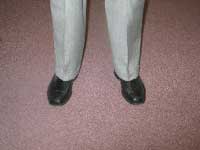
When you're anchored, you're standing in the "Speaker's Stance." Your weight is evenly distributed between both legs and your toes are slightly flared, giving the appearance of openness. (If your feet are exactly parallel to each other, you actually look awkward and insecure. Just flaring the toes a bit gives the appearance of confident strength.)
Here's a photo of a non-anchored person. Her weight is more on her left leg than her right.
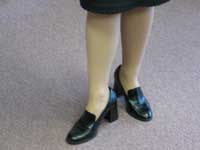
Take another look at this photo. She's also standing in the "ballerina" stance. She's "out of balance." Standing slightly sideways in this position reduces a person's credibility substantially, and is one of the greatest power robbers of all time. This stance has been taught especially to women for millennia, but "times they are a'changin'." Thank goodness. With women assuming their rightful place in the boardroom, this decorative pose has got to go!
Here are a couple of other ways people often get "off their stance" and lose their image of solidity:
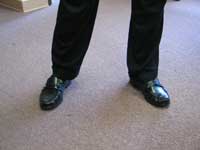
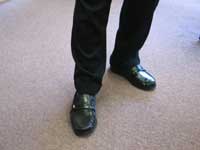
Here, the person on the left has all his weight on the left hip, while the other leg trails to the side. Soon, that hip will get tired and he'll shift his weight to the right side. This action creates the rocking that we often see in non-skilled speakers. The person on the right is putting his right foot forward, which also will result in a rocking motion.
Now look at these two.
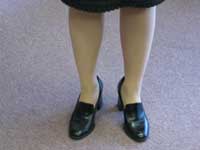
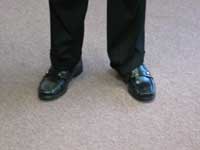
They're standing with their feet in the same plane, with their heels about 3-5 inches apart (depending on overall body frame), and with their toes slightly flared. If you could see their whole bodies, you'd notice that they look comfortable and balanced, their posture is good and their shoulders are square. When the stance looks good (to someone observing), it also feels most comfortable to the person standing. At Disneyland, where employees often must stand in one place for long periods of time, yet always look confident and approachable, they are taught to stand exactly like this. In Anaheim, California, and Orlando, Florida, this is called the "Disneyland Stance," but we know it as the "Speaker's Stance." All good speakers know to immediately find their balanced "Speaker's Stance" and stick to it.
Does this mean our speaker can never move? Not at all. Skillful speakers know to move at natural thematic transitions in the speech, then re-establish their "Speaker's Stance." Many people from the teaching profession find it hard to resist the urge to pace while speaking; but the fact is, public speaking is more physically disciplined than teaching. Too much foot movement is distracting to an audience.
The "Speaker's Stance" conveys confidence, stability, strength, and poise. Now, do people actually say, "Boy, that ballerina must really be disempowered! Look, she's off her 'Speaker's Stance.'" Of course not. The cues given nonverbally like this don't register in the conscious mind, but rather back in the brainstem. And if a person gives out enough such cues, that's when people draw conclusions that can be detrimental to the speaker's impact.
In an upcoming issue of People Skills for Skilled People, we'll take a look at the next place you need to be
anchored-your head.
Yours in communication excellence!
Jan and Neal Larsen Palmer
Communication Excellence Institute
And that's our tip on People
Skills for Skilled People for today!
In the weeks ahead, we'll be sending you more practical tips and
ideas on communication that you can put to use right away.
If you'd like to read previous
issues of People Skills
for Skilled People, please click
here.
We hope you'll enjoy and benefit from People Skills for Skilled People.
If you want to opt-out, please click on this button:

If
you've received this issue from a friend, you can have People
Skills for Skilled People sent
directly to you. Just go to our web site at www.talk2cei.com to
sign up.
For more information on Communication
Excellence Institute, please visit our website at www.talk2cei.com.

|
|








